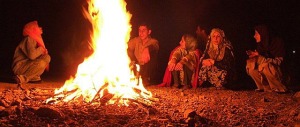I used to find writing prompts annoying. I mean, they didn’t add up to anything. They just sat there in a notebook. Magnificent or pointless, they were words that would never be published or publishable, that would probably never be read again.
But lately I’ve been giving prompts in most of my classes. I’m doing them myself and finding them oddly freeing. Sometimes they’re just a single word or simple concept: “Write about insects… a spatula…. your first memory…. Write about something worth stealing.”
In class, we generally free-write only for about ten minutes. Sharing is always optional. Since we’re really just spitting on the page, it’s stupid to expect much. Often enough, I’ve gone back to read my own responses to my exercises and discovered just a bunch of mismatched thoughts. Free association, irrelevancies. Other times, I’ve found kernels of brilliance.
These prompt-writing moments bring back a feeling that I’d forgotten – when I was 7 years old, discovering that I loved to dance. I had no dreams of tutus and sugarplum fairies when I first heard the music coming from that rundown rec-hall at my New Hampshire summer camp. It was a beautiful solo piano piece – Beethoven’s Moonlight Sonata, though I didn’t know it at the time. All I knew was that it called to me.

The dance counselor was working on some choreography when I quietly took a corner and started to move. After a moment she paused her own work to watch, and a few weeks later, I performed my improvisation before an audience of campers and counselors. In that moment of complete freedom, the marriage of movement and music, and the succeeding applause, my future plan to become a dancer was sealed.
Well, I can’t dance like that anymore, not only because I’m no longer so young or in shape for pirouettes and grand jetes. It’s because I spent years learning what was right and wrong through training. Technique embedded itself in my body until the initial inspiration and joy were nearly strangled. It took me years to undo the binds of that rigorous training until I found a shadow of the original joy that had moved me before I knew anything about anything.
The same danger lies in the process of writing. We can get caught up, even lost, as we work our way through a big project, or even a small one. We can write ourselves into corners, or edit until we’ve killed the very thing we were attempting to nurture. We can work so hard that we forget why we’re writing in the first place.
Herein lies the grace and benefit of prompts. They’re moments of total letting go. They have no greater purpose than to explore, to recall the freedom that comes at that first, naive moment of free-writing. We use them to stretch, to reach deep into muscles that perhaps we’ve forgotten to use in the midst of our struggles with an especially difficult story, memoir or novel. The only objective of a prompt is to let the words flow, just as I danced as a child.
Oddly, my youngest writing students often struggle with prompts. They can verbalize fantastic stories, but when they have to write them down, it’s as if the words get stuck somewhere between their minds, mouths and pencils. I’ve often asked kids to just tell me what they imagine, then simply say, “Great. Now write that down.” Over and over, moment by moment, “What’s next? What will your character do? How does your character feel about what just happened? OK. Write that down.” They often speak their thoughts in simple, beautiful words. So I say, “Now grab them! Just write them down on the paper before they fly away.”
Because words are difficult to master – their shape, their spelling, their syntax, are not natural to us the way they are in spoken form. Just the opposite of the primal act of dance, music, even storytelling, with writing, training must come before inspiration. To solidify our thoughts into lasting form is a sophisticated skill that requires education and practice.
So, with older students and adults, I take joy in the smoother flow of pen on paper. I revel in the scratchings as we all open the gates and let the words slip down. As I listen, sometimes I hear pauses, breathing spaces, or perhaps tighter curves in the flow of thought. I murmur, “Don’t worry. Just keep going,” recalling Natalie Goldberg’s advice to just keep your pen moving no matter what.
I assure my students that these ten minute spitting sessions won’t add up to brilliance. They shouldn’t. Just like stretching before a run or a dance, these fluid moments of non-judgment and free writing are just that – warm-ups. Improvisations.
So I give you the gift of a few prompts for the holidays. This week’s New York Times Magazine online featured a series of videos, Fourteen Actors Acting. Each short film is wordless, accompanied only by music. The actors’ emotions are vivid and clear. As the subtitle states, they are intentionally iconic character types from the silver screen, but each moment can be interpreted in infinite ways.

Click and watch a few. Absorb their feeling, their moment. Imagine their circumstances, their settings, their lives. Then write for ten minutes or as long as you like. And don’t judge what you write. If there’s a glittering kernel there, you’ll find it. Just enjoy the slip and flow of pen on paper, jamming, improvising, dancing as words form on the page.
Happy holidays. I wish you all good writing.


